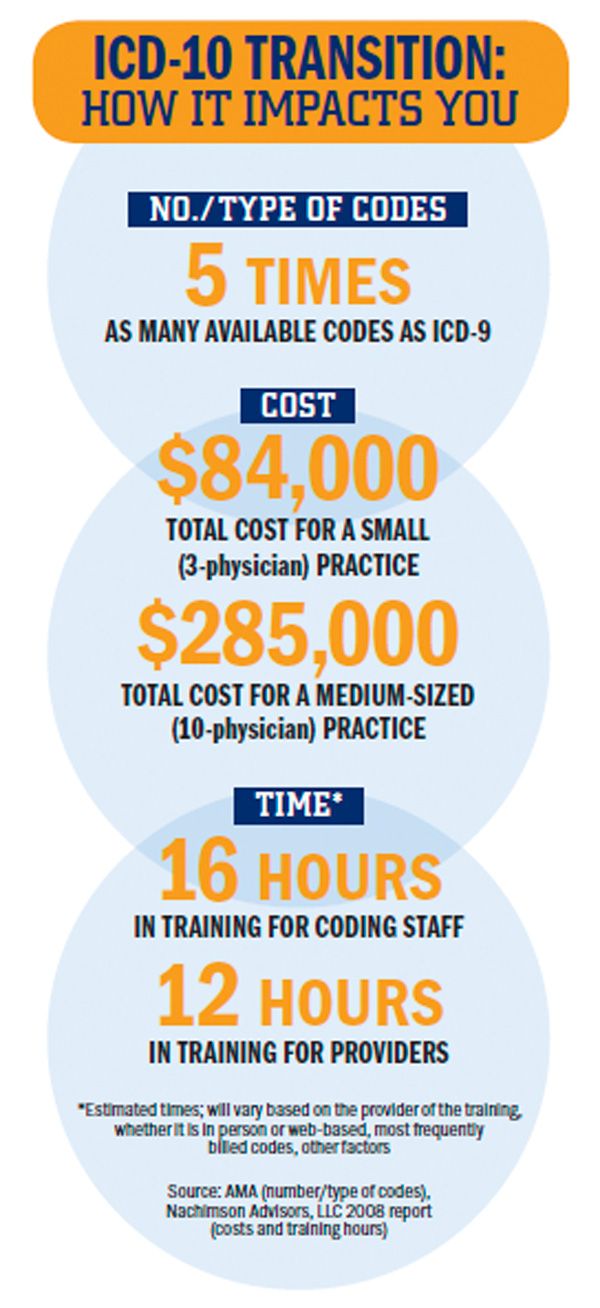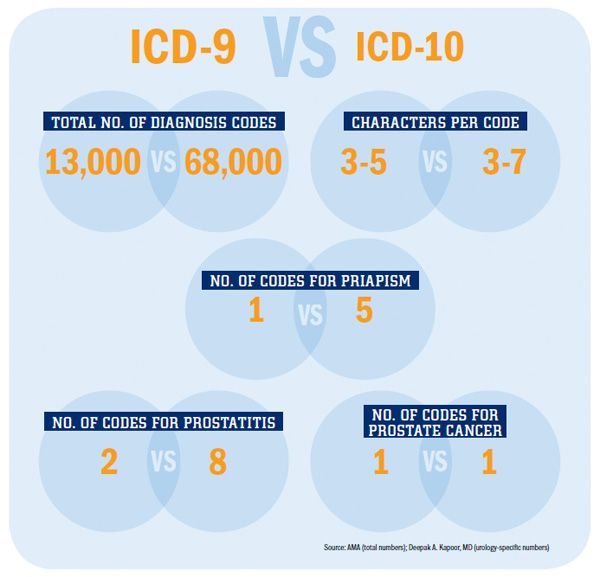Article
The switch to ICD-10: Are you ready?
The transition to ICD-10 is not just another thing on urologists’ plates. It’s the main course, and time to prepare for the change is running short.
National Report-The transition to ICD-10 is not just another thing on urologists’ plates. It’s the main course, and time to prepare for the change is running short.
According to the Centers for Medicare & Medicaid Services, providers covered by HIPAA must have updated their office technology, trained their staffs, and be ready to start coding in compliance with the International Classification of Diseases, 10th Edition, Clinical Modification, better known as ICD-10, beginning Oct. 1, 2014.

Continue to next page for more.
Mark Stovsky, MD, MBA, a urologist at Glickman Urological and Kidney Institute at Cleveland Clinic, Cleveland, says this will impact urologists, their nurses and non-physician providers, front desk people, coding, billing, lab and radiology services-whether it’s a huge enterprise like Cleveland Clinic or a one-person practice.

Dr. Stovsky“Most physicians really have a poor understanding of what they’re faced with as we go from ICD-9 to ICD-10. It’s really analogous to Y2K for billing and coding,” Dr. Stovsky said. “The implementation date is complicated by the fact that while all of a practice’s billing and coding and documentation systems have to be in compliance with ICD-10 on Oct. 1, all the claims submitted prior to Oct. 1 will be managed under the old ICD-9.”
Dr. Stovsky, who serves on the AUA Health Policy Council, as well as the AUA North Central Section and American Association of Clinical Urologists’ boards, looks at this issue from a large practice perspective. The Cleveland Clinic multispecialty group in which he practices is one of the largest in the country, with thousands of doctors. Cleveland Clinic, which also operates hospitals and outpatient surgery centers, will have to be in compliance with both sides of ICD-10-Clinical Modification (CM) and ICD-10 Procedure Coding System (PCS), which is for inpatient procedure coding.
Most urologists, however, are concerned only with ICD-10-CM.
Either way, ICD-10 seems inevitable, says Mark Painter, CEO of PRS Data in Denver.
“The vendors who have a pretty good lobby in all of this have spent a lot of money getting ready for ICD-10. CMS has moved forward. So, a lot of groundwork is in place. But I do think there are a number of practices that have not really dealt with this,” Painter said.
According to Rick Rutherford, CMPE, CHA, AUA’s director of practice management, the AUA has been trying to improve members’ awareness of the issue for several years.
“However, with the continuous efforts toward postponement, we fear many urologists are still in a ‘wait and see’ mode,” Rutherford said.
But the tide could be changing, he says.
“Recently, questions are starting to increase from AUA members about what they should be doing to prepare,” according to Rutherford.
Urologists aren’t alone. The Medical Group Management Association (MGMA) conducted a mid-June survey of practices, which found practices are moving slowly toward ICD-10 compliance. Survey results show a lack of communication and coordination between physician practices and their vendors regarding software updates and testing, and less than 5% of practices say they have made significant progress toward their overall readiness for ICD-10 implementation.
It’s easy to understand why urologists are among those providers who seem to be dragging their feet, according to Painter.
“There are a lot of other things going on that they are trying to deal with: implementation of the Affordable Care Act and local pressure to merge or sell to a hospital,” Painter said.
A rocky road
While ICD-10 might be new to U.S. physicians, it’s the accepted coding system in other major international markets. It is more complex a system than ICD-9, which has some 13,000 three- to five-digit diagnostic codes. ICD-10 CM swells to 68,000 three- to seven-digit codes.
CMS maintains the transition is necessary because ICD-9 produces limited data about patients’ medical conditions and hospital inpatient procedures.
“ICD-9 is 30 years old, has outdated terms, and is inconsistent with current medical practice. Also, the structure of ICD-9 limits the number of new codes that can be created, and many ICD-9 categories are full,” according to the CMS website.

The American Medical Association doesn’t agree and has fiercely opposed the change, successfully postponing implementation for a year.
“According to CMS, [ICD-10] is a done deal, but the AMA continues to advocate that ICD-10 is burdensome to physicians, provides no direct benefits to patients, and is going to compete with a lot of overlapping regulatory requirements,” said Steven J. Stack, MD, AMA trustee and immediate past chair. “So, we are advocating that ICD-10 should be stopped, and we should not go forward with it. In the event that we do go forward with it, [we advocate for] a 2-year implementation period during which physicians are not allowed to be penalized by payers and insurers as they make this transition from ICD-9 to ICD-10.”
Still, Dr. Stack, who practices as an emergency room physician in Lexington, KY, says physicians need to start planning.
“The deadline of October of 2014 is one that the government currently is firmly committed to, and physicians need to start planning and preparing for this,” Dr. Stack said.
There’s more

Dr. KapoorICD-10 captures more discreet data fields-data, where physicians check boxes or enter fields, versus make notes-which allows for high-level claims’ auditing, according to Deepak A. Kapoor, MD, president of the Large Urology Group Practice Association, and chairman and CEO of the largest urology practice in the U.S., with more than 100 doctors, based in Melville, NY.
“Rather than try to analyze data that may or may not be captured… you make the coding system much more nuanced. Unfortunately, a more nuanced system translates into a much more complex coding system,” Dr. Kapoor said.
Urologists and their staffs will have more to document within the ICD-10 system. One example: priapism, which is a single code in ICD-9. There are five priapism codes in ICD-10 that describe it in greater detail, including “unspecified,” “due to trauma,” “due to disease classified elsewhere,” “drug-induced,” and “other priapism.”
The AUA’s Rutherford says acute cystitis, code 595.0 under ICD-9, expands to N300, acute cystitis; N3000, acute cystitis without hematuria; and N3001, acute cystitis with hematuria.

Mr. Rutherford“Other forms of cystitis have similar expansions,” according to Rutherford. “Another example is urethral strictures. The code for traumatic urethral stricture under ICD-9 is 598.1. This applied to both genders. Under ICD-10, there are codes for traumatic urethral strictures among males with specific codes for anatomic locations such as meatus. There are additional codes among females.”
Physicians, in general, believe it’s a level of detail that is unnecessary, according to Dr. Stack.
“It does not add value or clarity to the quality of care being provided,” he said.
Ironically, ICD-10, with all its bells and whistles, has serious shortcomings, according to Dr. Kapoor.
“One of the things that we really desperately need is more nuanced coding for prostate cancer. In ICD-9, there was one code for prostate cancer. In ICD-10, there’s one code for prostate cancer,” Dr. Kapoor said.
On the other hand, coding for prostatitis will go from two to eight codes, he says.
“In order to be in compliance [with ICD-10], you have to code to the highest degree of specificity,” Dr. Kapoor said.
If providers don’t comply, they have more than lack of reimbursement to worry about, according to Dr. Kapoor. Willful or chronic violations could result in fines, he says.

Ms. StinchcombThe AUA has been working with the National Center for Health Statistics (NCHS) on the transition from ICD-9 to ICD-10 to make sure urology diagnosis codes are appropriate, according to Stephanie N. Stinchcomb, CPC, CCS-P, ACS-UR, the AUA’s senior manager of reimbursement and regulation.
“There are still issues with the urologic grafts and implant section. We continue to work with NCHS to adequately identify urologic diagnosis codes. The AUA has attended the ICD Coordination and Maintenance Committee meetings for the past several years to make sure the transition for urology goes as smoothly as possible,” Stinchcomb said.
Dollars for change
Cost estimates to make the transition vary according to practice size, whether practices have electronic health records (EHRs), and other factors.
“Back in 2008, we worked with a number of provider organizations, including the American Medical Association, in trying to identify what the cost would be for practices to transition to ICD-10. That included things like training, upgrades, loss of productivity, things like that,” said Robert Tennant, senior policy adviser at the Medical Group Management Association. “We found that for a three-physician practice, we estimated the cost would be about $84,000. These costs are going to hit folks like urologists very, very hard, because… none of these costs will be covered by the government. These will be borne by the physicians, themselves.”
For a typical medium-sized practice, the total cost of the ICDâ10 mandate would be $285,195, according to the report “The Impact of Implementing ICDâ10,” by Nachimson Advisors, LLC, released in October 2008. And for a typical large practice, Nachimson Advisors estimates the total cost as $2.7 million.
Making a plan

Mr. PainterExperts say that while it’s too early to start training, it’s not too early to begin the process.
If whole practices train too early, they might forget or their training might become obsolete, according to Painter.
“You only get conversive in a language when you’re using it regularly. I equate CPT and ICD as kind of a language of communication of billing. If you start getting ready too early and don’t really use it, you’re probably not going to remember it,” Painter said.
For now, Rutherford says, practices need to establish an ICD-10 transition task force. The task force should develop a training budget and a training timeline to ensure preparations are completed by October 2014. He suggests practices take advantage of the training offered by their specialty society.
“Next, they should communicate directly with the IT vendors (EHR and practice management systems) to determine the plans for necessary programming updates and the costs,” Rutherford said.
In the meantime, the AUA is developing a full-day basic training seminar that will be available to members in a virtual format, according to Rutherford.
“In addition, there will be web-based learning tools and a urology-specific crosswalk from ICD-9 to ICD-10. This material will be available before the end of 2013. All of our coding education in 2014 will include additional ICD-10 modules to continue to enhance urologists’ preparation,” Rutherford said.
Staff is integral to the training, according to Rutherford. While some staff members should serve on the task force, all staff members should undergo some amount of training based on their job description.

“Start now to generate reports from your practice management system to identify the most frequently used ICD-9 codes so that crosswalks can be developed that fit your practice needs,” Rutherford said.
Dr. Stovsky says consultants have recommended beginning coding instructions and the basics of the switchover from ICD-9 to ICD-10 in April 2014. System instruction should be done from July to August of 2014, and testing of the system and staff in August and September, using coding scenarios to make sure that the systems that are implemented meet ICD-10’s coding criteria.
Here’s something else to think about: According to Dr. Stovsky, coding consultants predict practices will experience significant decreases in productivity with implementation. There might also be delays in payment as practices get accustomed to the new system. As a result, practices should consider having cash reserves in preparation for implementation.
Silver linings
In addition to making the U.S. medical system more compatible with the rest of the world, ICD-10’s greater detail and specificity should improve and expand outcomes research, Dr. Stovsky says.
There could be reimbursement benefits, too, he says.
“It allows you to adjust coding and reimbursement for severity of disease, which is not really possible in ICD-9 coding. It allows for more accurate reimbursement, based on the specifics of the problem being treated. Therefore, it may actually allow for faster claims processing,” Dr. Stovsky said. “And because we’re giving the payers more information, claims may be denied less often.”
Painter says some of the gloom and doom surrounding ICD-10 implementation is sensationalized. In fact, Painter says, some urology codes will remain similar after ICD-10 becomes reality.
“You have a code for a calculus of the kidney [in ICD-9], and there’s only one code in ICD-10,” Painter said. “There are a number of places where there really are not significant changes.”
Good or bad, ICD-10 is real, and the time to begin preparations is now, experts say.
Urologists should not assume that the conversion will not take place in October, 2014, Rutherford says.
“I think that it’s like jumping into a swimming pool and the temperature is not exactly to your liking,” Dr. Kapoor said. “You can go ahead and stand around the pool and continuously stick your toe in, and it’s going to take you a long time, and you’re really going to suffer. Or you can just hold your nose and take the plunge. It’s going to really hurt upfront, but you’ll get used to the water a lot quicker that way.”UT
ICD-10 transition resources
ICD-10 basics from CMS
www.cms.gov/medicare/coding/ICD10
CMS General Equivalence Mappings (GEMs)*
http://www.cms.gov/Medicare/Coding/ICD10/2014-ICD-10-CM-and-GEMs.html
*Good starting point, but do not rely on this resource exclusively
List of diagnosis, procedure codes from CMS
http://www.cms.gov/Medicare/Coding/ICD9ProviderDiagnosticCodes/codes.html
AMA resources
www.ama-assn.org; search for ICD-10 resources
Subscribe to Urology Times to get monthly news from the leading news source for urologists.

















